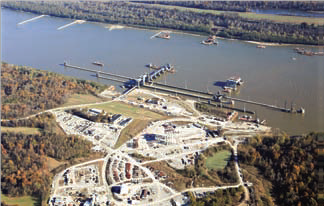Olmsted To Go Into Operation This Summer
After 30 years of construction and funding delays, the nearly $3 billion Olmsted Locks and Dam project on the Ohio River near Olmsted, Ill., is nearing completion four years ahead of schedule, and will go into operation this summer. When that happens, the Corps will transition locking on that portion of the river from Locks and Dams 52 and 53 to Olmsted.
Originally, the project was scheduled to be completed in 2022, with the eventual removal of Locks and Dams 52 and 53 a few years later to facilitate the movement of barge traffic through one of the busiest stretches of the inland waterways. Locks and Dams 52 and 53 have been in operation, despite several recent failures, since 1928.
This announcement comes on the heels of the president’s budget for Fiscal Year 2019, which includes $4.785 billion in gross discretionary funding for the Civil Works program of the Corps. This means that the Corps’ Olmsted project is now funded to completion after being listed in the budget for $35 million.
Continuing Work At Olmsted
Michael Braden, Olmsted Locks and Dam division chief for the Corps, told The Waterways Journal that recent rains have led to higher river levels, which has stalled some building activities at Olmsted until May. “We’re doing work on the hillside and planning work for this summer in the interim,” he said, adding that all of the dam components have been installed after engineers set the last shell on December 28 and completed concrete work in January. “A key piece of operational equipment, the wicket lifter, also recently arrived, so our crews have been busy familiarizing themselves with it.”
The wicket lifter, said Braden, will be in the testing phase for a while, but it will allow the Corps to hold pool in an emergency situation now that the dam structure is in place.
Braden said that having Locks and Dams 52 and 53 in operation while work continues on Olmsted is advantageous. “We’re looking at removing a portion of Lock 53, which has a low operation profile three to four weeks out of the year,” he said. “We’ll make that decision over the next 30 to 45 days. We’ll start off with considerations to remove portions of Lock 53 this year, and if that’s not successful, then our commander will do a risk assessment to determine whether it’s riskier to operate Lock 52 or to just use Olmsted. Everything will fully transition by October, but if we have issues, we’ll assess and operate [Olmsted] sooner rather than later.”
Shortly after the transition to Olmsted, Braden said the Corps would look at demolishing Lock 53, so that tows no longer have to navigate around it.
Braden said the twin 1,200-foot lock chambers and the 2,500-foot dam at Olmsted will provide for more reliable navigation on that stretch of the lower Ohio River for at least 50 years. Braden said the mood of those working on the Olmsted project has been mostly one of pride, with some wistfulness as the project wraps up.
“The years 2012 to 2013 weren’t the brightest moment for the project,” said Braden, who said funding issues held the project back for years. “It was on the verge of being shut down. Since then, our production rates have gone through the roof, though.” Braden added that the Corps recently released $330 million of its budget—a dividend check that Olmsted proudly paid back—meaning the project will not only be completed ahead of schedule, but also under budget.
“When that last shell went down in December, there was a little sadness for the team,” added Braden. “It was the end of an era for government and contractors, who worked closely together over the last three to four years.”

Braden said the team has been discussing the disposal of the project’s large, custom-built pieces of equipment, which have been landmarks at the site for years. Braden said the project’s catamaran barge is the largest in the world, and its gantry crane is the second largest in the world. “It’s just a little sad,” he said. “But everyone knew this would be coming and we know we have been working toward this. It’s a part of the construction business.”
The Olmsted project is underway between Illinois and Kentucky approximately 17 miles from the confluence of the Ohio and Mississippi rivers. It has been reported that the new structure will produce an average of more than $640 million in economic benefits annually. Currently, up to 90 million tons of cargo move through Locks 52 and 53 each year.



